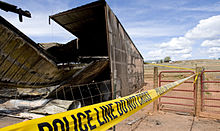
ISO 3864 specifies international standards for safety signs and markings in workplaces and public facilities. These labels are graphical, to overcome language barriers. The standard is split into four parts.

A biological hazard, or biohazard, is a biological substance that poses a threat to the health of living organisms, primarily humans. This could include a sample of a microorganism, virus or toxin that can adversely affect human health. A biohazard could also be a substance harmful to other living beings.

Safety is the state of being "safe", the condition of being protected from harm or other danger. Safety can also refer to the control of recognized hazards in order to achieve an acceptable level of risk.

A hard hat is a type of helmet predominantly used in workplace environments such as industrial or construction sites to protect the head from injury due to falling objects, impact with other objects, debris, rain, and electric shock. Suspension bands inside the helmet spread the helmet's weight and the force of any impact over the top of the head. A suspension also provides space of approximately 30 mm between the helmet's shell and the wearer's head, so that if an object strikes the shell, the impact is less likely to be transmitted directly to the skull. Some helmet shells have a mid-line reinforcement ridge to improve impact resistance. The rock climbing helmet fulfills a very similar role in a different context and has a very similar design.

Hazard symbols or warning symbols are recognisable symbols designed to warn about hazardous or dangerous materials, locations, or objects, including electromagnetic fields, electric currents; harsh, toxic or unstable chemicals ; and radioactivity. The use of hazard symbols is often regulated by law and directed by standards organizations. Hazard symbols may appear with different colors, backgrounds, borders, and supplemental information in order to specify the type of hazard and the level of threat. Warning symbols are used in many places in place of or in addition to written warnings as they are quickly recognized and more universally understood, as the same symbol can be recognized as having the same meaning to speakers of different languages.

Traffic cones, also called pylons, witches' hats, road cones, highway cones, safety cones, caution cones, channelizing devices, construction cones, roadworks cones, or just cones, are usually cone-shaped markers that are placed on roads or footpaths to temporarily redirect traffic in a safe manner. They are often used to create separation or merge lanes during road construction projects or automobile accidents, although heavier, more permanent markers or signs are used if the diversion is to stay in place for a long period of time.
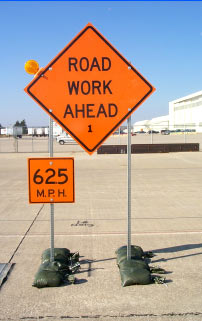
Safety orange is a hue used to set objects apart from their surroundings, particularly in complementary contrast to the azure color of the sky. The high-visibility color is commonly used for hunting during the rifle season, and is also used for upland-bird hunting. Places such as construction sites use this orange to help ensure the safety of others.

Road surface marking is any kind of device or material that is used on a road surface in order to convey official information; they are commonly placed with road marking machines. They can also be applied in other facilities used by vehicles to mark parking spaces or designate areas for other uses. In some countries and areas, road markings are conceived as horizontal traffic signs, as opposed to vertical traffic signs placed on posts.
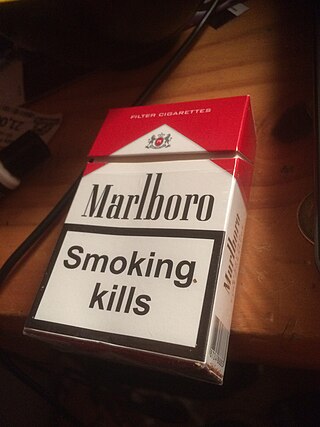
A warning label is a label attached to a product, or contained in a product's instruction manual, warning the user about risks associated with its use, and may include restrictions by the manufacturer or seller on certain uses. Most of them are placed to limit civil liability in lawsuits against the item's manufacturer or seller. That sometimes results in labels which for some people seem to state the obvious.
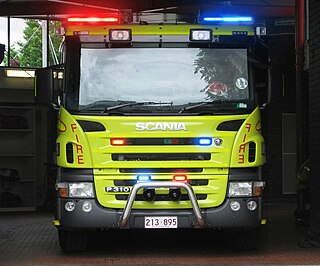
Emergency vehicle lighting, also known as simply emergency lighting or emergency lights, is a type of vehicle lighting used to visually announce a vehicle's presence to other road users. A sub-type of emergency vehicle equipment, emergency vehicle lighting is generally used by emergency vehicles and other authorized vehicles in a variety of colors.
In United States safety standards, precautionary statements are sentences providing information on potential hazards and proper procedures. They are used in situations from consumer product on labels and manuals to descriptions of physical activities. Various methods are used to bring focus to them, such as setting apart from normal text, graphic icons, changes in text's font and color. Texts will often clarify the types of statements and their meanings within the text. Common precautionary statements are described below.
ANSI Z535 is an American standard that sets forth a system for presenting safety and accident prevention information. It corresponds to the international ISO 3864 standard and can be integrated with other ISO standards to meet global HazCom standards when products and related documentation must be properly labeled for export.
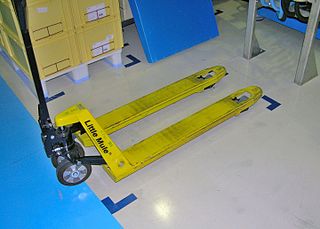
Floor marking tapes are adhesive tapes used to mark hazards, divide spaces, create aisles, or provide directions. They are commonly used in industrial and manufacturing facilities for floor marking. They are made of multiple different materials, including PVC and vinyl, and vary in thickness from 5-mils to 55-mils for a wide range of durability options for manufacturing facility floor marking. The best floor marking tapes are usually 50 to 60 mils thick. Most tapes come in a variety of color options and even hazard patterns to meet U.S. Occupational Safety and Health Administration/ANSI requirements and other safety standards. Some tapes are made with higher reflectivity and may even glow in the dark.
Machine guarding is a safety feature on or around manufacturing or other engineering equipment consisting of a shield or device covering hazardous areas of a machine to prevent contact with body parts or to control hazards like chips or sparks from exiting the machine. Machine guarding provides a means to protect humans from injury while working nearby or while operating equipment. It is often the first line of defense to protect operators from injury while working on or around industrial machinery during normal operations. In the U.S., machine guarding is referred to in OSHA's CFR 1910.212; in the U.K., machinery safety is covered mainly by PUWER."

In the process industry, chemical industry, manufacturing industry, and other commercial and industrial contexts, pipe marking is used to identify the contents, properties and flow direction of fluids in piping. It is typically carried out by marking piping through labels and color codes. Pipe marking helps personnel and fire response teams identify the correct pipes for operational, maintenance or emergency response purposes.

Mr. Ouch is a hazard symbol developed by the US’s National Electrical Manufacturers Association (NEMA) to represent electrical hazard within pad-mounted transformers. Unlike other high-voltage warning symbols, Mr. Ouch was specifically designed with young children in mind. It is part of NEMA Standard 260-1996, Safety Labels for Pad-Mounted Switchgear and Transformers Sited in Public Areas, which lays out design guidelines for a complete label design that incorporates the Mr. Ouch symbol.

Workplace robotics safety is an aspect of occupational safety and health when robots are used in the workplace. This includes traditional industrial robots as well as emerging technologies such as drone aircraft and wearable robotic exoskeletons. Types of accidents include collisions, crushing, and injuries from mechanical parts. Hazard controls include physical barriers, good work practices, and proper maintenance.

Safety signs are a type of sign designed to warn of hazards, indicate mandatory actions or required use of Personal protective equipment, prohibit actions or objects, identify the location of firefighting or safety equipment, or marking of exit routes.
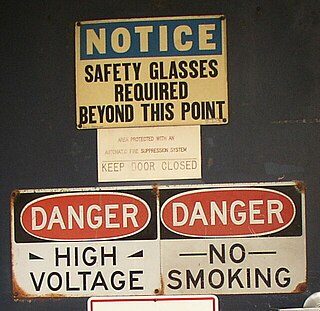
ANSI Z35.1 the Specifications for Accident Prevention Signs, was an American standard that dictated the layout, colors and wording of safety signs in the United States. The standard is the first American standard that made specific demands for the design, construction, and placement of safety signage in industrial environments. The first edition was published in January 1941, and the fourth and final edition in November 1972. Changes in societal needs of signage, and further research into signage would result in the establishment of a new committee, the ANSI Z535 Committee on Safety Signs and Colors, combining the separate committees of Z35.1 - Specifications for Accident Prevention Signs, Z35.2 - Specifications for Accident Prevention Tags, and Z53 - Marking Physical Hazards Safety Color Code, resulting in a new combined standard, ANSI Z535.

The Health and Safety Regulations 1996 specify the safety signs within Great Britain, Northern Ireland has a similar law. It was issued as a transposition of the European directive 92/58/EEC and replaced The Safety Signs Regulations 1980. They consist of "traditional safety signs", such as prohibitory and warning signs, hand signals, spoken and acoustic signals and hazard marking.


